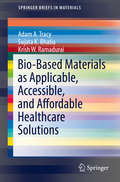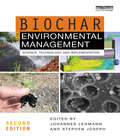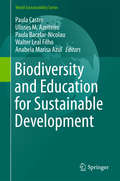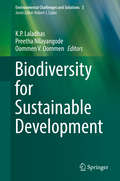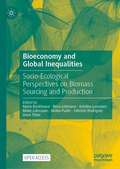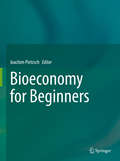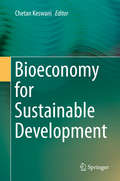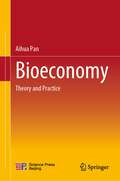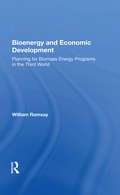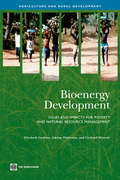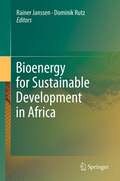- Table View
- List View
Bio-Based Materials as Applicable, Accessible, and Affordable Healthcare Solutions (SpringerBriefs in Materials)
by Sujata K. Bhatia Krish W. Ramadurai Adam A. TracyIn this book, Nigeria, the most populous country in Africa and a region in the lowest income group per capita, is used to demonstrate the potential for healthcare reorganization and collaboration with the introduction of "successful" technologies centered around available, bio-compatible, and sustainable natural resources. Our book discusses three of the top killers of children under 5 years of age in Nigeria, pneumonia (20%), diarrheal diseases (15%), and traumatic injuries (4%). These conditions are used as examples to demonstrate the potential for improved pediatric outcomes with treatments engineered from sustainable and natural resources. Furthermore, this book outlines possible action items that can help drive economic growth, educational opportunities, collaborative outreach, and workforce productivity to build a healthy and sustainable community. Medical technology in the industrialized world has seen rapid advancements leading to increased survival and greater patient outcomes. However, the development and implementation of these resources is not always applicable to regions in need of new and more basic ways to provide treatment. Moore's Law, a paradigm that considers advancement synonymous with increased digitization and optimization of electronic processes, defines the history of technology. However, the functionality of advanced and "smart" technology is essentially useless in underdeveloped areas. These regions lack some of the basic requirements for innovative medical technologies to impact human health, such as electricity, access to spare parts, computer analysis tools, and network architecture. In addition, the poor physical infrastructure, insufficient management, and lack of technical culture are barriers for entry and sustainability of these technologies. Rather than importing medical devices from industrialized countries, we propose that the mindset and research focus for under developed areas must be on "successful" technologies. Simply put, these areas need technology that "gets the job done. "
Bio-Economic Models applied to Agricultural Systems
by Guillermo FlichmanThis book has the purpose of providing the "state of the arts" concerning bio-economic modelling dealing with agricultural systems. In most cases, the contributions use a methodology combining the use of biophysical and economic models, in all cases, an engineering production function approach is totally or partially applied. This practice is being developed in the last years as a response to concrete policy matters: agricultural policies are increasingly combined with environmental and natural resources policies, and this reality involves the need of an integrated assessment, that current economic models are not able to provide.
BioTransplant, Inc.: Initial Public Offering, January 1996
by Paul A. Gompers Alexander TsaiExamines the decision to go public. BioTransplant is an early stage biotechnology company that must decide how to finance its research and development. The pros and cons of public offerings are analyzed versus alternative financing sources.
Biobot Analytics
by Mitchell B. Weiss Joshua Lev Krieger Raymond KluenderIn 2017, Newsha Ghaeli and Mariana Matus were deciding whether to leave their labs at the Massachusetts Institute of Technology, put other job opportunities aside, and dive full-time into founding a wastewater analysis start-up, Biobot. Ghaeli, an architect, and Matus, a computational biologist, had been turning sewage into information about "population health" and now had dreams of turning the data encoded in urine and stool into a viable and impactful business. In plainer terms, they planned to "tap into what you flush down the toilet every day." They'd been told not to. They'd been told their idea was too broad and their skills too narrow. They'd been told they had no defensible intellectual property and limited scalability. They'd been advised to choose other startups instead, and knew, as immigrants on temporary visas, if they failed at this venture, they might even have to leave the country. Despite the many hurdles and objections, Ghaeli and Matus felt mostly at ease about moving ahead. Were they missing something? Or was everyone else?
Biochar for Environmental Management: Science, Technology and Implementation
by Stephen Joseph Johannes LehmannBiochar is the carbon-rich product which occurs when biomass (such as wood, manure or crop residues) is heated in a closed container with little or no available air. It can be used to improve agriculture and the environment in several ways, and its persistence in soil and nutrient-retention properties make it an ideal soil amendment to increase crop yields. In addition to this, biochar sequestration, in combination with sustainable biomass production, can be carbon-negative and therefore used to actively remove carbon dioxide from the atmosphere, with potentially major implications for mitigation of climate change. Biochar production can also be combined with bioenergy production through the use of the gases that are given off in the pyrolysis process. The first edition of this book, published in 2009, was the definitive work reviewing the expanding research literature on this topic. Since then, the rate of research activity has increased at least ten-fold, and biochar products are now commercially available as soil amendments. This second edition includes not only substantially updated chapters, but also additional chapters: on environmental risk assessment; on new uses of biochar in composting and potting mixes; a new and controversial field of studying the effects of biochar on soil carbon cycles; on traditional use with very recent discoveries that biochar was used not only in the Amazon but also in Africa and Asia; on changes in water availability and soil water dynamics; and on sustainability and certification. The book therefore continues to represent the most comprehensive compilation of current knowledge on all aspects of biochar.
Biochar for Environmental Management: Science, Technology and Implementation
by Stephen JosephFully revised and updated for its third edition, this book presents the definitive compilation of current knowledge on all aspects of biochar.Research on biochar continues to accelerate as its importance for soil health, climate change mitigation and adoption, and the circular economy becomes more widely acknowledged. This book not only reviews recent advances made in our understanding of biochar properties, behavior, and effects in agriculture, environmental management, and material production, but specifically develops fundamental principles and frameworks of biochar science and application. This third edition has been fully revised and updated to reflect recent developments and growing trends, with important coverage of the application of biochar outside of its traditional soil-based uses, the commercialization of biochar, and its incorporation into policy. This includes brand new chapters on the role of biochar-based materials for environmental remediation, building construction, and animal feed, and a greater discussion of biochar's role in the circular economy, climate change mitigation, and sustainable development. Overall, this book provides a systematic, comprehensive, and global examination of biochar. Written by an international team of academics and professionals, it addresses its uses, production, and management and its broader potential for mitigating climate change and driving forward sustainable development.Edited by two leading figures in the field, Biochar for Environmental Management is essential reading for students, scholars, practitioners, and policymakers interested in biochar and the role it can play in environmental sustainability and global sustainable development.Chapter 16 of this book is freely available as a downloadable Open Access PDF at http://www.taylorfrancis.com under a Creative Commons Attribution-Non Commercial-No Derivatives (CC-BY-NC-ND) 4.0 license.
Biocon: Launching a New Cancer Drug in India
by Sunil Gupta Das NarayandasKiran Majumdar-Shaw, the CEO of Biocon has to make product launch timing, pricing, channel, and communications mix decisions relating to the launch of BioMAb, a new cancer drug in India.
Biodata (Routledge Revivals): Biographical Indicators of Business Performance
by Adrian Furnham Barrie Gunter Russell DrakeleyFirst published in 1993. This book is intended for managers and occupational psychologists involved in the selection and assessment of the workforce. It details the history and development of the use of biographical data for both recruitment and promotion of employees. Grounded in relevant research literature, it offers a comprehensive analysis of the advantages and disadvantages of biodata in different contexts. It also includes examples of applications and recommendations for use, as well as examples of questionnaires. Written by experts, it represents a wide-ranging review of the contemporary research in the field. This work will be of interest to students of business and psychology.
Biodiversity Conservation Through Access and Benefit Sharing (ABS): Himalayas and Indian Sub-Continent
by K. P. Laladhas Oommen V. Oommen Prakash Nelliyat Balakrishna PisupatiThis book deals with the economic potentials of biodiversity and its capacity to support its own conservation aiming to provide livelihood for millions engaged in conservation, both now and for future generations. The book highlights the potentials of natural resources which are characterized as capital wealth (as defined in Convention on Biological Diversity (CBD)), to finance its own conservation and to provide livelihood means to people who conserve it.The book is divided into five Parts. PART I explains about the Premise of Access and Benefit Sharing (ABS), PART II describes about the Technology Transfer, PART III will provide details about the Access to Genetic Resources and to Associated Traditional Knowledge and Benefit Sharing PART IV is the Implementation of ABS Mechanisms and PART V is about ABS and Its Economics.This book will be of interest to biodiversity policy makers, administrators, university and college students, researchers, biodiversity conservationists.
Biodiversity and Education for Sustainable Development (World Sustainability Series)
by Walter Leal Filho Ulisses M. Azeiteiro Paula Castro Paula Bacelar-Nicolau Anabela Marisa AzulThis book gathers interdisciplinary reflections fromresearchers, educators, and other experts on the subject of biodiversity closerto education and learning. The book also highlights its role as an added valueto strategic principles for healthy ecosystems and sustainable humandevelopment. It promotes critical thinking and foster practices and attitudesfor Education for Sustainable Development reconciling education with principlesof human behaviour and nature. Readers especially find this book a timelyresource in light of the Strategic Plan for Biodiversity 2011-2020, the AichiTargets, and the new EU biodiversity strategy "Our life insurance, our naturalcapital: an EU biodiversity strategy to 2020". Along with the challenge ofecosystems and public health, biodiversity conservation is essential forhumanity's continued security and sustainability, as it touches on all aspectsof people's lives.
Biodiversity for Sustainable Development (Environmental Challenges and Solutions #3)
by K. P. Laladhas Preetha Nilayangode Oommen V. OommenDivided into three sections, this book explores the three main pillars of sustainable development, namely economy, environment and society, and their interlinkages at the regional level. The first section, Access and Benefit Sharing (ABS) for sustainable development, focuses on international agreements and national legislation, as well as the challenges in implementing ABS in e. g. India. In turn, the second section examines the process of forming Biodiversity Management Committees (BMCs) at the Local Self Government (LSG) level to promote environmental sustainability, highlighting local and community-level conservation initiatives that have led to the conservation of habitats and species. The third section addresses poverty eradication and food security. The case studies included demonstrate how the combination of traditional knowledge and modern techniques can enhance the productivity of traditional crop varieties, yielding greater benefits for communities. The aim of this volume is to disseminate the lessons learned from these case studies, as well as the findings from projects already in place, which can offer recommendations that can be applied to similar problems elsewhere in an attempt to find environmental solutions for sustainable development. Further, it introduces readers to new approaches to inclusive development, demonstrating that participation and grass root empowerment are key drivers of equitable and sustainable development.
Biodiversity in the Green Economy (Routledge Studies in Ecological Economics)
by Alexandros Gasparatos Katherine J. WillisIn the past decade, the growing realization that biodiversity and human wellbeing are inextricably linked has led to the adoption of numerous environmental policies. The concept of the Green Economy has gained particular attention as an economic system where growth is possible within environmental limits. The preservation of ecosystem services and the halt of biodiversity loss are identified as key pillars of the Green Economy. Despite the concept’s momentum there is still no clear understanding of how biodiversity fits within a Green Economy. In the current debate, biodiversity is rarely acknowledged in economic sectors other than agriculture, forestry, fisheries and tourism, and when it is acknowledged biodiversity and its conservation feature more as buzzwords than as concrete and tangible components of the Green Economy. This book aims to identify, understand and offer pragmatic recommendations of how biodiversity conservation can become an agent of green economic development. This book establishes ways to assess biodiversity’s contributions to the economy and to meaningfully integrate biodiversity concerns in green-economy policies.
Biodiversity, Genetic Resources and Intellectual Property: Developments in Access and Benefit Sharing (Routledge Research in Intellectual Property)
by Charles Lawson Kamalesh AdhikariDebates about Access and Benefit Sharing (ABS) have moved on in recent years. An initial focus on the legal obligations established by international agreements like the United Nations Convention on Biological Diversity and the form of obligations for collecting physical biological materials have now moved to a far more complex series of disputes and challenges about the ways ABS should be implemented and enforced: repatriation of resources, technology transfer, traditional knowledge and cultural expressions; open access to information and knowledge, naming conventions, farmers’ rights, new schemes for accessing pandemic viruses and sharing DNA sequences, and so on. Unfortunately, most of this debate is now crystallised into apparently intractable discussions such as implementing the certificates of origin, recognising traditional knowledge and traditional cultural expression as a form of intellectual property, and sovereignty for Indigenous peoples. Not everything in this new marketplace of ABS has been created de novo. Like most new entrants, ABS has disrupted existing legal and governance arrangements. This collection of chapters examines what is new, what has been changed, and what might be changed in response to the growing acceptance and prevalence of ABS of genetic resources. Biodiversity, Genetic Resources and Intellectual Property: Developments in Access and Benefit Sharing of Genetic Resources addresses current issues arising from recent developments in the enduring and topical debates about managing genetic resources through the ABS regime. The book explores key historical, doctrinal, and theoretical issues in the field, at the same time developing new ideas and perspectives around ABS. It shows the latest state of knowledge and will be of interest to researchers, academics, policymakers, and students in the fields of intellectual property, governance, biodiversity and conservation, sustainable development, and agriculture.
Bioeconomies: Life, Technology, and Capital in the 21st Century
by Vincenzo Pavone Joanna GovenThis book explores the promissory discourses and practices associated with the bioeconomy, focusing especially on the transformation of institutions; the creation, appropriation, and distribution of value; the struggle over resources, power, and meaning; and the role of altruism, kinship, and care practices. Governments and science enthusiasts worldwide are embracing the bioeconomy, championing it as the key to health, wealth, and sustainability, while citing it as justification to transform research and regulatory institutions, health and agricultural practices, ethics of privacy and ownership, and conceptions of self and kin. Drawing together studies from Asia, Australia, the Americas, and Europe, this volume encompasses subjects as diverse as regenerative medicine, population health research, agricultural finance, biobanking, assisted reproduction, immigration, breastfeeding, self-help groups, GM fish, and mining sewage.
Bioeconomy and Global Inequalities: Socio-Ecological Perspectives on Biomass Sourcing and Production
by Rosa Lehmann Anne Tittor Maria Backhouse Kristina Lorenzen Malte Lühmann Janina Puder Fabricio RodríguezThis open access book focuses on the meanings, agendas, as well as the local and global implications of bioeconomy and bioenergy policies in and across South America, Asia and Europe. It explores how a transition away from a fossil and towards a bio-based economic order alters, reinforces and challenges socio-ecological inequalities. The volume presents a historically informed and empirically rich discussion of bioeconomy developments with a particular focus on bio-based energy. A series of conceptual discussions and case studies with a multidisciplinary background in the social sciences illuminate how the deployment of biomass sources from the agricultural and forestry sectors affect societal changes concerning knowledge production, land and labour relations, political participation and international trade. How can a global perspective on socio-ecological inequalities contribute to a complex and critical understanding of bioeconomy? Who participates in the negotiation of specific bioeconomy policies and who does not? Who determines the agenda? To what extent does the bioeconomy affect existing socio-ecological inequalities in rural areas? What are the implications of the bioeconomy for existing relations of extraction and inequalities across regions? The volume is an invitation to reflect upon these questions and more, at a time when the need for an ecological and socially just transition away from a carbon intensive economy is becoming increasingly pressing.
Bioeconomy for Beginners
by Stephan Meyer Wolfgang Zettlmeier Ulrich SchurrThis book provides an interdisciplinary and comprehensible introduction to bioeconomy. It thus provides basic knowledge for understanding a transformation process that will shape the 21st century and requires the integration of many disciplines and industries that have had little to do with each other up to now. We are talking about the gradual and necessary transition from the age of fossil fuels, which began around 200 years ago, to a global economy based on renewable raw materials (and renewable energies). The success of this transition is key to coping with the challenge of climate change. This book conceives the realization of bioeconomy as a threefold task – a scientific, an economic and an ecological one. · Where does the biomass come from that we need primarily for feeding the growing world population but also for future energy and material use? How can it be processed in biorefineries and what role does biotechnology play in this regard? · Which aspects of innovation economics need to be considered, which economic aspects of value creation, competitiveness and customer acceptance are important? · What conditions must a bioeconomy fulfil in order to enable a sustainable development of life on earth? May it be regarded as a key to further economic growth or shouldn’t it rather orient itself towards the ideal of sufficiency? By dealing with these questions from the not necessarily consistent perspectives of proven experts, this book provides an interdisciplinary overview of a dynamic field of research and practice that raises more questions than answers and thus may nurture the motivation of many more people to seriously engage for the realization of a bioeconomy.
Bioeconomy for Sustainability
by Vinod Kumar Garg Navish KatariaThis edited volume covers the key role of bioeconomy for next-generation industrial production to achieve Sustainable Development Goals. It addresses the key environmental challenges due to biowaste generation and their application in boosting the economy through the conversion of biowaste into valuable products for sustainable growth and future needs. This book also describes the potential future research scope and possibilities in bioeconomy towards sustainable industrial ecology and circular economy. In recent years, competition has increased for determinate resources. There is an urgent need to look for sustainable, non-polluting alternate sources to meet the demands of an ever-increasing population. Sustainable processes and production while using biological material can produce food, fodder, agricultural inputs, fuel etc. with lesser inputs and reduced emission of pollutants. Agricultural waste and food waste are another concern which demands immediate interventions. The Bioeconomy can be a possible way to address these challenges. It includes sustainable production of food, fodder, fiber, fuel, agricultural inputs, and other goods while using renewable resources or different types of waste. This is beneficial to resolve diverse environmental problems such as future bioenergy production technology, societal transformations, pollution management, industrial circular economy, agricultural practices and food securities, climate management etc. Bioeconomy helps to move from a linear economy to a circular economy. This book is a valuable source for researchers, teachers, and undergraduate and graduate students of environmental science, environmental economics, agriculture science, biotechnology, ecology, and soil science. It also serves as additional reading material for professionals, scientists, stakeholders of government and non-government organizations, industrialists, and policymakers of the relevant fields.
Bioeconomy for Sustainable Development
by Chetan KeswaniThe current era of incredible innovations has made science and technology one of the most powerful tools to meet the goals of incremental prosperity for humans and sustainable development. The development of the biotech industry in any given country is shaped by the characteristics of the technology—particularly its close relation to scientific knowledge—and by country-specific factors—the level and nature of the scientific knowledge base, the institutional set-up, and the role assumed by the government—which influence the country's ability to exploit new opportunities and appropriate the respective results.This book presents an integrated approach for sustained innovation in various areas of biotechnology. Focusing mainly on the industrial, socio-economic and legal implications of biotechnological advances, it examines in detail not only the implications of IPR in omics-based research but also the ethical and intellectual standards and how these can be developed for sustained innovation.Integrating science and business, it offers a peek behind the scenes of the biotech industry and provides a comprehensive analysis of the foundations of the present day industry for students and professionals alike. The book is divided into three parts: Food and Agricultural BiotechnologyIndustrial BiotechnologyPharmaceutical Biotechnology
Bioeconomy of Streptomyces
by Kashyap Kumar Dubey Punit KumarThis book provides a comprehensive understanding of streptomycetes, highlighting their various habitats, diversity, genetic structure, and metabolic engineering techniques to enhance the production of secondary metabolites. It also presents techniques for the isolation, cultivation, biochemical identification, chemotaxonomy, and phylogenetic analysis of streptomycetes. The book explores the production of bioactive compounds from streptomycetes, including novel natural products, antimicrobial agents, pharmaceuticals, medicinal compounds, and bioactive enzymes. Furthermore, the book examines the diverse applications of streptomycetes in agriculture, medicine, industry, and bioremediation. The chapters emphasize the latest technological advancements such as bioprocess optimization, genetic engineering, metabolic engineering, genome mining, and pathway engineering for enhancing the production of secondary metabolites from Streptomyces. As such, this book is of interest to academicians, researchers, and professionals working in the fields of bioprocessing, microbiology, industrial microbiology, medical microbiology, fermentation technology, and biotechnology.
Bioeconomy: Shaping The Transition To A Sustainable, Biobased Economy (Economic Complexity And Evolution Ser.)
by Iris LewandowskiThis book is at the cutting edge of the ongoing research in bioeconomy and encompasses both technological and economic strategies to master the transformation towards a knowledge- and bio-based production system. The volume combines different international perspectives with approaches of the various fields of research. Bioeconomy is one of the future concepts of an economy which, while based on renewable biological resources, also predicts economic growth. Starting from a growth-economic as well as knowledge- and innovation-economic perspective the contributions give an overview of different existing patterns and cases and describe the basic prerequisites for the bioeconomy transformation. Therewith, the volume is a resource for experts and newcomers in the field of bioeconomy giving insight into the life cycle of bio-based products, detailing the latest advancements and how to turn them into economic growth.
Bioeconomy: Theory and Practice
by Aihua PanThis book focuses on the new concept of bioeconomy which collects the wisdom from life science, medicine and economics. lt finds the origins from ten existing theories, and also regards as “Pan's bioeconomy”. It has provided new methods for economic science research, opened up new fields for life science research, provided the right answer for China's economic miracle, filled the gap between materialism and idealism, and removed the fence between natural science and social science
Bioenergy And Economic Development: Planning For Biomass Energy Programs In The Third World
by William C RamsayBioenergy, a promising alternative for developing countries, is already a key resource (in the form of fuelwood, for example) in millions of households around the world. Third World planners are exploring new technologies and uses, including the production of biogas from wastes for household cooking, the burning of wood chips under boilers to produ
Bioenergy Development: Issues and Impacts for Poverty and Natural Resource Management
by Gerhard Dieterle Elizabeth Cushion Adrian WhitemanBioenergy has been critically important since our ancestors first used wood to cook their food and stay warm at night. Traditional forms of bioenergy, firewood and cow dung patties, remain primary fuel sources for many rural and poor people. More modern sources of bioenergy--including ethanol and biodiesel for transport and wood pellets for heating, among many others--offer great promise but generate great controversy. This book gives an overview of bioenergy developments. It examines the main issues and possible socioeconomic implications of these developments, as well as their potential impacts on land use and the environment, especially with respect to forests. The authors present an introduction to bioenergy, provide a background and overview of solid biomass and liquid biofuels, and examine the opportunities and challenges at the regional and country levels. They also examine potential impacts for specific types of bioenergy. 'Bioenergy Development' does not attempt to be definitive on such subjects as the impact of bioenergy on food prices, but it does suggest the tradeoffs that need to be examined when considering bioenergy policies. The authors offer five main findings: Solid biomass will continue to provide a principal source of energy and should not be overlooked. There will be major land-use implications resulting from bioenergy developments. It is critical to consider tradeoffs-including those related to poverty, equity, and the environment-when considering bioenergy policies. There is considerable potential for an increased use of forestry and timber waste as a bioenergy feedstock. The climate change impacts of bioenergy development are uncertain, and highly specific to location and feedstock.
Bioenergy for Sustainability and Security
by Ajit Varma Basanta Kumara BeheraThis book discusses the generation of green energy, providing fundamental scientific information on the availability of sustainable biological resources. It addresses inter- and multidisciplinary topics, including policies and strategies for sustainable energy; the environment and advanced renewable energy technology; electricity generation through solid waste management; and direct electricity generation using microbial fuel cells. It examines the application of the principles and quantitative relationships that define the process – as an effective technique to teach applied aspects of biomass energy technology conversion. In addition, it describes the latest commercialisation of microbial fuel cell technologies, bio-diesel production from microalgae, fermentation technology based on biobutanol from bacteria, and direct ethanol production from microalgae with attractive illustrations and models developed by corporate sectors.
Bioenergy for Sustainable Development in Africa
by Dominik Rutz Rainer JanssenThe work builds on the results of the COMPETE Bioenergy Competence Platform for Africa, which was supported by the European Commission and coordinated by WIP Renewable Energies, Germany. The five sections cover biomass production and use, biomass technologies and markets in Africa, biomass policies, sustainability, and financial and socio-economic issues. This valuable work is, in effect, a single-source treatment of a key energy sector in a part of the world which still has a lot of unrealised potential for development.
